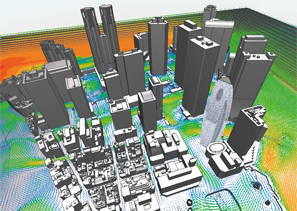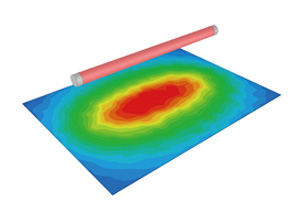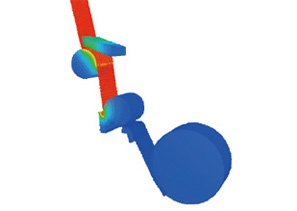HeatDesigner

Features
HeatDesigner is a structured (Cartesian) mesh thermal fluid analysis software specially designed for electronics cooling thermal analysis. It uses core technology from Software Cradle's scSTREAM general purpose structured mesh thermal-fluid software product.
HeatDesigner's performance is optimized for applications that do not require precise reproduction of fine geometrical curvature to predict an accurate flow field. However, HeatDesigner is capable of accommodating meshes with over a hundred million elements enabling it to capture fine geometrical details. Like scSTREAM, the major advantages of HeatDesigner are fast calculations times and low memory consumption.
Program Structure

Large-scale calculation
In structured mesh, even a complicated model does not need to be modified almost at all and the shape or the scale of a model does not affect the difficulty of mesh generation. In addition, Solver performs a calculation at a high speed in parallel computing and achieves effective processing as the speed increases depending on the number of subdomains.

Multiblock
Mesh can be refined partially to represent a model shape more accurately and perform a calculation more efficiently.

Part library
The shapes and conditions of frequently used parts can be registered. Conditions include the allocation position, material, and heat generation.

HeatPathView
The information on temperature of each part and a comprehensive amount of heat release obtained in post-processing of a general CFD analysis is not enough to know the heat path. HeatPathView displays heat paths and the amount of heat transfer in the whole computational domain in a diagram, a graph, and a table, allowing you to find the bottleneck of the heat paths easily.

ElectronicPartsMaker
The tool can create detailed models of semiconductor packages including QFP, SOP, and BGA by specifying parameters, and simplified models using thermal resistor models such as DELPHI models and two-resistor models. Manufacturers of semiconductor packages can provide the data of semiconductor packages as thermal resistor models without releasing the inside information.

Reading wiring patterns
To calculate heat transfer conditions depending on wiring patterns of a printed circuit board (PCB) in detail, the module can read Gerber data output from an electric CAD tool and import the data as a model for a thermo-fluid analysis. By using Gerber data, a more realistic calculation result can be obtained with the consideration of heat transfer affected by an uneven wiring pattern.

Radiation
Radiation heat transfer with the consideration of diffusion, reflection, transmission, refraction, and absorption can be calculated. VF (view factor) method and FLUX method*1 can be used. The lamp function can simulate radiant heat by a filament without detailed shape information of a lamp. In addition to the filament, laser beam and defective radiation specified by half-value angle can be used as a heat source model.
*1 Only for scSTREAM

Calculation of structure function
Modeling of electronic device is possible by converting result data of heat change over time used for transient heat resistance measurement*2 into structure function (thermal resistance - heat capacity characteristics). Accurate thermal model can be generated by comparing test and analysis data on the basis of structure function.
*2 Measurement device is not included

Electronic part model
A wide range of models are available that enable to easily achieve thermal design of printed circuit boards and electronical enclosures, which includes DELPHI (multi-resistor) model, Peltier device and heat pipes. It is possible to consider pressure loss characteristics using slits, and P-Q characteristics of fans using swirling component. Generated models can be added in library.

Panel
(heat conduction / transfer / thermal transport)
Material properties and motion conditions can be applied to a panel having no thickness in model, which allows for heat conduction to other parts and heat dissipation to air. This enables the simulations of paper feeding and film drying processes, where thin objects move and go under heating repetitively.
* Transfer and thermal transport are only available on scSTREAM






